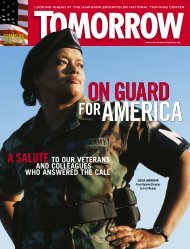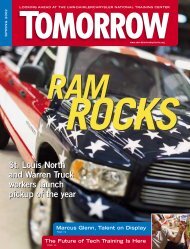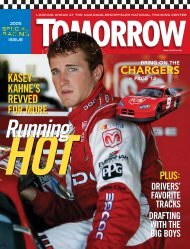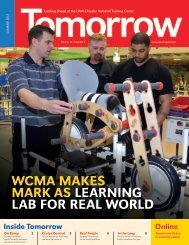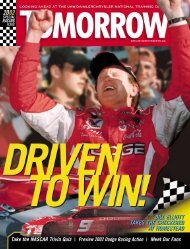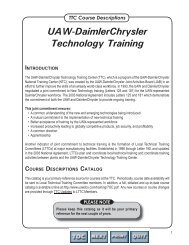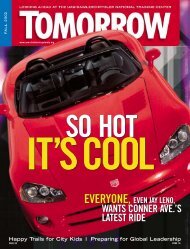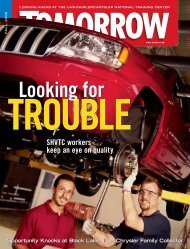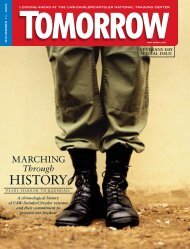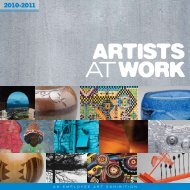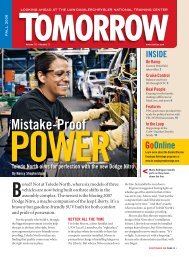Create successful ePaper yourself
Turn your PDF publications into a flip-book with our unique Google optimized e-Paper software.
to test-drive a racecar. It was stolen once<br />
in California and found stripped on milk<br />
crates. The Dodge engineering team<br />
hauled it back to Michigan, where it was<br />
reborn as a test car. It’s now on display<br />
at the International Motorsports Hall<br />
of Fame and Museum at Talladega<br />
Superspeedway.<br />
The breakthrough success of the<br />
winged cars couldn’t have happened<br />
without similar Dodge spark and<br />
teamwork — or without embracing a<br />
calculated risk in pursuit of innovation.<br />
The result was a landmark win<br />
for driver Richard Brickhouse. His<br />
No. 99 Nichels Engineering Dodge<br />
Charger Daytona took the inaugural<br />
event at Alabama International Motor<br />
Speedway on Sept. 14, 1969. As with<br />
Charger teams today, teamwork and<br />
unity from top to bottom bred success.<br />
Ray Fox Sr., for example, was a Dodge<br />
mechanic who contributed to 140 Grand<br />
National victories in the 1960s and ’70s.<br />
He once built an engine overnight for a<br />
race on the old Daytona Beach course.<br />
“Some of the guys didn’t want to get paid<br />
for what they did,” he recalls. “They<br />
helped because they wanted to have<br />
something to do with racing.”<br />
THE GLORY DAYS<br />
Ask Petty about the initial glory period<br />
of the Dodge Charger, and he’s not<br />
bashful about ranking the Charger as<br />
his No. 1 racecar. He’s described it as a<br />
universal car, one that could drive well<br />
anywhere — road course, short track or<br />
CHARGER MILESTONES<br />
Championships in Dodge Chargers: David Pearson (1966–67);<br />
Buddy Baker (1967–68, 1970–73); Ray Elder (1971–72); Sam<br />
McQuagg (1966); Bobby Isaac (1968–1972); Richard Petty (1973–77);<br />
LeeRoy Yarbrough (1966–67); Charlie Glotzbach (1968, 1970);<br />
Dave Marcis (1975–76); Bobby Allison (1967, 1969–71);<br />
Richard Brickhouse (1969); Neil Bonnett (1977)<br />
Earl Balmer drives the No. 3 car to the first-ever NASCAR win in a Dodge<br />
Charger on Feb. 25, 1966, at Daytona.<br />
Richard Brickhouse’s No. 99 Nichels Engineering Dodge Charger<br />
Daytona is the first “winged” stock car to win a NASCAR race on<br />
Sept. 14, 1969, the inaugural event at Alabama International<br />
Motor Speedway.<br />
The Dodge Charger Daytona wins its first NASCAR Grand National race<br />
at Talladega in September 1969. It also wins at Texas International<br />
Speedway that year. The next year, it wins at Atlanta, Michigan and<br />
Darlington. Ironically, it never wins at its namesake track, Daytona.<br />
Buddy Baker is the first driver to officially crack 200 mph in a closedcourse<br />
lap, hitting 200.447 mph at Talladega on March 24, 1970, in the<br />
No. 88 Dodge Charger.<br />
Driver Ray Elder wins the first-ever Winston Cup Series event with a<br />
Dodge Charger, at the Riverside International Raceway road course in<br />
California on Jan. 10, 1971. (Back then, Riverside held the first<br />
event, not Daytona.) Elder — who was a full-time farmer and only<br />
raced part-time — is one of three Dodge drivers to win on-road<br />
courses, the others being Petty and Bobby Allison.<br />
Neil Bonnett, driving the No. 5 Dodge, earns the last win of the first<br />
Charger era on Nov. 20, 1977, passing Petty with five laps to go.<br />
superspeedway. But Petty also reveals<br />
that it was more than simply about a car.<br />
He fondly recalls the sense of <strong>com</strong>munity<br />
the Dodge Charger inspired — not<br />
simply among drivers and crews, but<br />
also fans. There was a high level of passion<br />
for the Chargers and the teams that<br />
got the best out of them. And drivers<br />
back then had more time to get to know<br />
fans and other teams.<br />
“When we first started, most<br />
NASCAR people stayed in one or two<br />
motels,” Petty explains. “Now there are<br />
so many people that they don’t really<br />
congregate outside the racetrack. On<br />
the other hand, the sport has gained a<br />
lot. A big crowd back then was 5,000 or<br />
6,000. Now, you have 100,000 fans.”<br />
Even back then, Charger victories<br />
translated to fame and fortune. The<br />
paychecks may not have been what<br />
they are today but, says Petty, they were<br />
still pretty good. “We won more races.<br />
We won more money,” he says. “We<br />
were doing more with cars than anyone<br />
else at that particular time.”<br />
As for the drivers themselves, were<br />
they better back then? While not passing<br />
judgment, Petty extends his admiration<br />
for today’s drivers, a sentiment<br />
echoed by Fernandez. “They were as<br />
skilled then as they are now,” says the<br />
Dodge Motorsports official. “The difference<br />
is that there are so many good<br />
to great drivers out there <strong>com</strong>peting<br />
today — more than 40 on a Nextel<br />
Cup track every single race.”<br />
With so much talent in the mix, what<br />
makes today’s teams rise to the top is<br />
teamwork. “Richard Petty would win by<br />
entire laps,” says Fernandez. “But today<br />
a few seconds will cover much of the field.<br />
With just a 14-second pit stop, you’ll lose<br />
too much position. And in the garage<br />
there’s less room for error. The team<br />
really has to produce a car that’s ready to<br />
race when it’s loaded in the hauler. With<br />
Charger, teamwork from start to finish is<br />
more critical today than ever.” ■<br />
Dodge Motorsports’ Bill Hamilton<br />
contributed to this report.<br />
16 www.uawdcx.<strong>com</strong>



